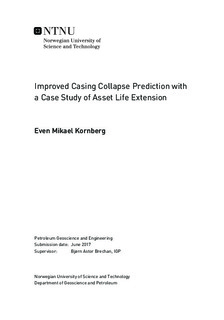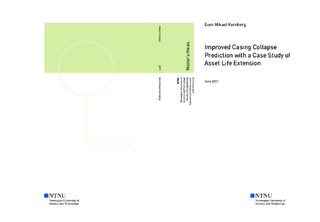| dc.description.abstract | The current industry accepted standards of predicting collapse strength of casings are pessimistic and inaccurate. With wells being drilled ever deeper, high strength pipes are required in order to comply with rules and regulations. A new ultimate limit strength (ULS) model is highly desirable.
A workgroup from ISO tasked with modernising current standards have identified the model introduced by Klever & Tamano in 2006 as the most accurate predictor of collapse strength. A simplified version of this model with calibrated parameters was suggested by ISO to replace the empirical API equations for casing collapse strength estimations.
This report reviews the predictive accuracy of the proposed model by comparison with a dataset, DEA-130, of 113 actual collapse tests. An adjustment was made to the model parameter, c, to best fit actual collapse pressures. For seamless, quenched & tempered, and hot rotary straightened casings the actual/predicted collapse strength ratio featured a Gaussian distribution with average of 0.999 and standard deviation of 0.0648.
Since actual collapse tests are limited an indirect method was used to estimate design collapse strength of a typical 9 5/8 in 53.5 ppf P-110 casing. This method requires only input parameter probability density functions (PDF). The PDFs for each input parameter were obtained by measurements of the 113 samples. The workgroup from ISO obtained similar PDFs from an ensemble of 20 datasets. Random value generators in a mathematical spreadsheet allowed for Monte Carlo simulations to output 100 000 collapse strength predictions for the 9 5/8 in casing in question. With confidence level of 97.5%, the basic strength was 9900 psi using DEA-130 PDFs. Using ensemble PDFs, the basic strength was 9500 psi considerably more than API s standard rating of 7950 psi.
Collapse resistance can be significantly altered by secondary effects. Experimental and numerical results of the effects of axial loading, internal pressure, imposed ovality, casing wear, and cement support were obtained by literature review and compared with the ULS model. Linear derating factors to account for imposed ovality and casing wear were implemented to the model. The increased collapse strength of compressed pipes were conservatively approximated by polynomial curve fitting of an alternative formulation of yield collapse strength and included in the model.
The new ULS model was used to evaluate the feasibility of asset life extension, i.e. prolonged production, of an existing well. Two loads were modelled: low pressure production and full evacuation of casing. With current industry standards the minimum bottom hole flowing pressure (BHFP) is 2500 psi, significantly more than the suggested design life extension pressure of 870 psi.
Using the new ULS model, the candidate well still cannot with confidence withstand the external pressure with full evacuation of the production casing. If BHFP is limited to 870 psi, up to 2.5% wear is allowed for non-ovalised casing. If the design factor of 1.1 is ignored, up to 10% wear is allowed. Moderate strength increase due to support from cement allows for safe operation even when including design factor. The critical point is then at top of cement where casing wear is likely and ovality may have been imposed. A casing collapse strength matrix as a function of wear and ovality was proposed for easy identification of minimum allowable internal pressure.
With some support of internal pressure and/or cement, maintaining well integrity at low pressure production is plausible but cannot be guaranteed | |

